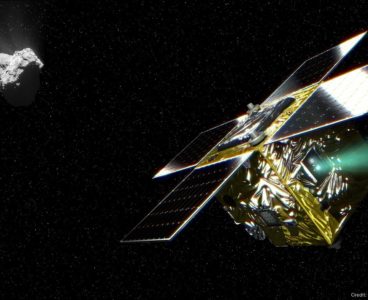In spintronics, the use of organic materials as a “spin transport material” has recently garnered significant attention as they exhibit long spin-relaxation times and long spin-diffusion lengths owing to the weak spin-orbit interaction (SOI) of light elements. Meanwhile, the weak SOI of organic materials become a drawback when they are used as a “spin filter”.…
Retreating Snow Line Reveals Organic Molecules Around Young Star
Astronomers using ALMA have detected various complex organic molecules around the young star V883 Ori. A sudden outburst from this star is releasing molecules from the icy compounds in the planet forming disk. The chemical composition of the disk is similar to that of comets in the modern Solar System. Sensitive ALMA observations enable astronomers…
Little Supernova is Big Discovery: The Origin of Binary Neutron Stars
An international research team discovered the first recorded “ultra-stripped supernova,” a rare, faint type of supernova that is believed to play a role in the formation of binary neutron star systems. These findings will advance our understanding of a wide variety of topics ranging from gravitational waves to the origin of precious metals like gold…
Double or Nothing: Astronomers Rethink Quasar Environment
In the Universe, galaxies are not distributed uniformly. There are some places, known as clusters, where dozens or hundreds of galaxies are found close together. Other galaxies are isolated. To determine how and why clusters formed, it is critical to investigate not only mature galaxy clusters as seen in the present Universe but also observe…
Surface Helium Detonation Spells End for White Dwarf
Some stars end their lives with a huge explosion called a supernova. The most famous supernovae are the result of a massive star exploding, but a white dwarf, the remnant of an intermediate mass star like our Sun, can also explode. This can occur if the white dwarf is part of a binary star system.…
Tail of Stray Black Hole Hiding in the Milky Way
It is difficult to find black holes, because they are completely black. In some cases black holes cause effects which can be seen. For example if a black hole has a companion star, gas streaming into the black hole piles up around it and forms a disk. The disk heats up due to the enormous…
Micro Spacecraft Investigates Cometary Water Mystery
In September 2015, a team of astronomers from the National Astronomical Observatory of Japan, University of Michigan, Kyoto Sangyo University, Rikkyo University and the University of Tokyo successfully observed the entire hydrogen coma of the comet 67P/Churyumov-Gerasimenko, using the LAICA telescope onboard the PROCYON spacecraft. They also succeeded in obtaining the absolute rate of water…
Calculating 1 Billion Plasma Particles in a Supercomputer
The generation of fusion energy utilizes the fusion reaction that occurs inside a high-temperature plasma. In order to achieve the generation of fusion energy, we confine plasma in the magnetic field with a doughnut configuration. Together with raising the temperature and the density in the plasma’s core region, it also is necessary to control the…








